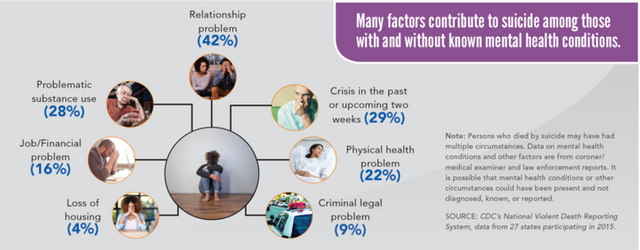The rate of people dying by suicide has increased in nearly every state since 1999. Some regions have been hit significantly harder than others

The recent deaths of internationally renowned chef Anthony Bourdain and fashion designer Kate Spade have renewed public focus on suicide. But the outpouring of grief on social media over the untimely deaths of these icons hides a larger trend, a country in the grips of a suicide crisis.
Nearly 45,000 Americans over the age of 10 died by suicide in 2016 alone ― that’s more than double the number of Americans who died by homicide in the same year.
And deaths by suicide have been steadily increasing across the country for nearly two decades, according to a new government report released on Thursday.
Researchers at the U.S. Centers for Disease Control and Prevention found that every state, except Nevada, has seen increases in deaths by suicide between 1999 and 2016, the last year for which data are available. And nearly half of those states had an increase of more than 30 percent.
Deb Stone, a behavioral scientist at the CDC and the lead author on the report, told HuffPost these state trends are “concerning and indicate that the problem is getting worse.”
CDC researchers can’t point to any one cause for this continued increase in suicide rates on a national level. But Stone said the lasting impact of the Great Recession and the opioid overdose epidemic are certainly possible factors.
“Those are a few things we might point to,” she added. “But we know it’s multiple factors, and the data just don’t tell us specifically which one.”
The data suggests that while the majority of communities across the country experienced a significant increase in suicide deaths, some regions were harder hit than others. Middle America and the Rocky Mountain West, for example, saw some of the biggest increases in suicide rates, suggesting specific cultural and social factors like gun ownership and opioid addiction may be contributing to their high suicide rates.
And while media reactions to high-profile celebrity deaths often increase the awareness of suicide and crisis hotlines, these tools alone are not enough. The CDC report found that the majority of people who died by suicide didn’t have known mental health diagnoses at the time of death.
“We want [people] in the community to be aware of the warning signs but also to be aware that there are other factors associated with suicide, such as relationship problems and financial problems,” Stone said.

While mental health conditions are often seen as a cause of suicide, the new CDC data showed that more than half of people (54 percent) who died by suicide did not have a known mental health condition at the time of death.
“What that means is that people either did not have a genuine diagnosis or they may have been struggling with mental health challenges and had a diagnosable condition that was either unknown or unreported,” Stone said.
There are financial and structural impediments to seeking help, but there are also cultural barriers. And men, who make up 84 percent of those with no known diagnosed mental health condition are particularly socialized to not seek help.
Men were not only more likely to die by suicide with no known mental health condition, but they were also more likely to die by using a firearm.
Michael Staley, suicide prevention research coordinator at the Utah Office of the Medical Examiner and a sociologist, told HuffPost this gender gap can be a major clue as to why suicide rates are so high in Utah and its neighboring states in Middle America.
In Utah, 75 percent of deaths by suicides were among men ― roughly 5 percent higher than national data.
“The gap in gender to me really is a big lead into understanding our problem,” Staley said. He hypothesized that the reason men are disproportionately affected is because men are generally taught from a young age that they must deal with their problems on their own.
“We genuinely discourage young men from help seeking,” he said. “There is ample evidence out there to suggest this inhibition of help-seeking behavior is a fundamental flaw in the way that we are teaching young men to emote.”
Middle America is suffering the most and it could be linked to slow recovery
CDC
Some of the highest range in increases during the report’s 17-year period were concentrated in and around Middle America. Montana, Idaho, Utah, Wyoming, North Dakota Kansas, Oklahoma and Minnesota all saw suicide rate increases between 38 and 58 percent.
While Stone said there is no known reason for why these states’ increases are so high, she points to the fact that these regions were hit hardest by both the Great Recession and the opioid epidemic. Also “people in rural areas tend to be more isolated, and they may have less access to mental health and behavioral health care, so it’s harder to get help,” she added.
Staley said there is truth in Stone’s analysis, though he argues the Great Recession and the opioid crisis do not paint a complete picture because both similarly impacted other regions of the country who did not see such drastic increases.
“None of these is a sole explanation, and no one is ever selling these as sole explanation for our suicide rate in the Rocky Mountain West, but those are factors that contribute at the very minimum,” he added.
But the CDC’s report did shed some light on the type of contributing factors that are causing these deaths by suicide on a national level. The most common factor was relationship problems (42 percent), followed by problematic substance use, crisis in recent or forthcoming weeks, criminal legal problems, physical health problems, loss of housing and financial problems.
The country’s suicide crisis is part of our gun problem
Staley also pointed out that in states like Utah, people are more likely to have access to one of the most common methods for deaths by suicide: firearms.
“You’re in the Rocky Mountain West, people are a lot more likely to have weapons here than they are in urban areas,” he said, adding that part of Utah’s suicide prevention efforts revolve around convincing people to lock up their firearms or remove them from their home if they are experiencing depression or suicidal thoughts.
In 2016, there were 38,658 firearms deaths in the United States ― 59 percent of these deaths were suicides.
This data, as well as the CDC’s findings, clearly indicate that before we can successfully address the nation’s increasing suicide rates, we must discuss certain structural factors: This includes gun control and safety, economic recovery and access to mental health care.
Author: Carolina Moreno
source:www.huffingtonpost.com
Hi! I am a robot. I just upvoted you! I found similar content that readers might be interested in:
https://www.huffingtonpost.com/entry/the-us-is-in-the-midst-of-a-suicide-crisis_us_5b1aa949e4b0bbb7a0dc4824
Downvoting a post can decrease pending rewards and make it less visible. Common reasons:
Submit